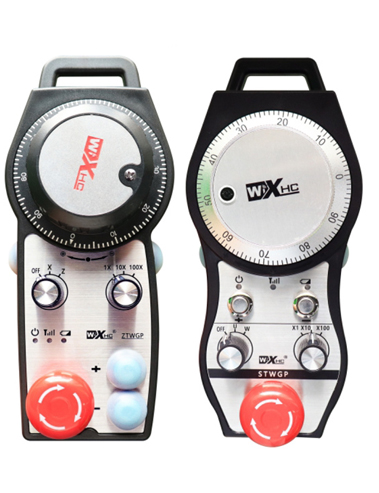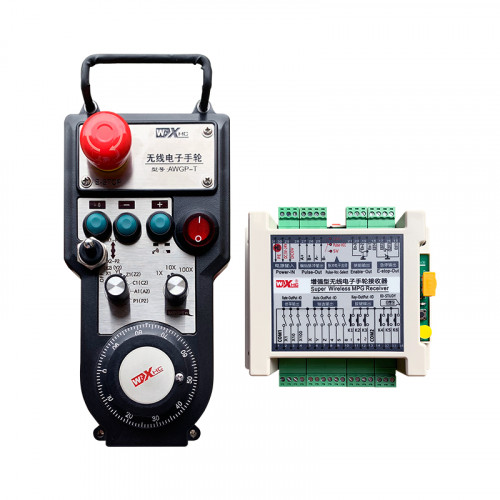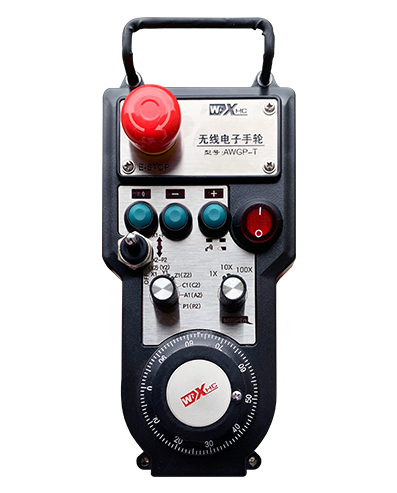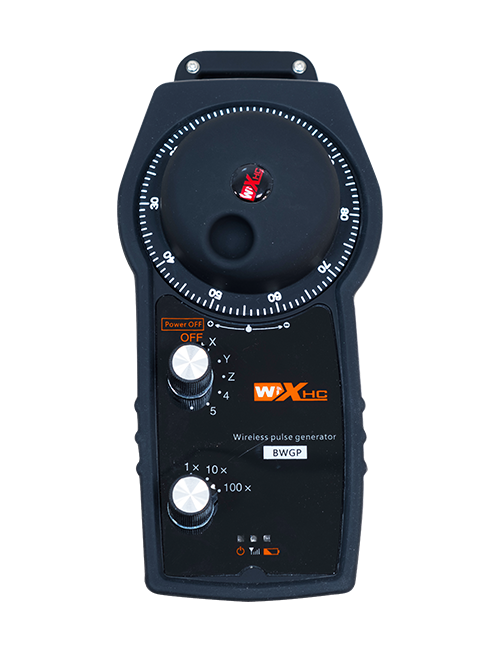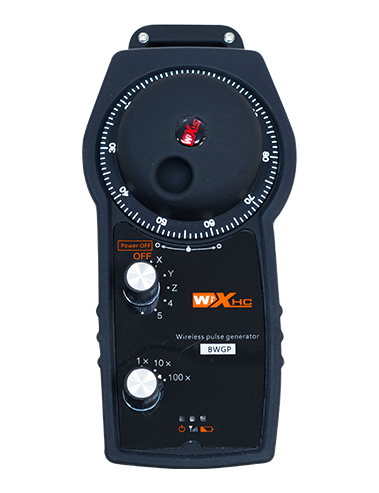ʻO nā mea mamao aku i hoʻokaʻawaleʻia no CNC CNTC TRYIcal Lathe
ʻO ka weheweheʻana

1.Huahana hou hoʻopuka
2. Product functional features
| Operating voltage and current of wireless remote |
3V/14MA
|
| Battery specifications | 2 AA alkaline batteries, size 5 |
| Low voltage alarm range of wireless remote | < 2.3V |
| Receiver power supply voltage | DC5V-24V/A |
| Receiver emergency stop output load range | AC125V-1A/DC30V-2A |
| Receiver enable output load range |
AC125V-1A/DC30V-2A
|
| Receiver custom button output load range | DC24V/50mA |
| Receiver axis selection output load range | DC24V/50mA |
| Receiver magnification output load range | DC24V/50mA |
| Transmission power of handheld terminal |
15dBm
|
| Receiver receiving sensitivity | -100dBm |
| Wireless communication frequency | 433MHz frequency band |
| Wireless communication distance | Barrier free distance of 40 Nā Moʻi |
| Operation temperature | -25℃ < X < 55℃ |
| Anti fall height | 1 (mluter) |
| Custom button quantity | 2 |


Nā moʻolelo:
① Pulse encoder:
E kaomi a hoʻopaʻa i ka pihi e hiki ai, shake the pulse encoder, emit a pulse signal,and control the movement ofthe machine axis.
② Enable button:
Press either enable button on either side, and the two sets of enable IO outputs on the receiver will conduct. Release the enable button to disconnect the enable IO output; And before switching the axis selection magnification and shaking the handwheel,the enable button needs to be held down to be effective; This function can be cancelled through configuration software.
③ Indicator lights:
Left side light: power on light,the handwheel uses the axis to select OFF for power on, and this light stays on after power on;
Middle light: a signal light that lights up when operating any function ofthe handwheel, and does not light up when there is no operation;
Right side light: Pau loa Haxt Alarm kukui, low battery level,this lightflashes or stays on, battery needs to be replaced.
④ Emergency stop button:
E kaomi i ke pihi STOCK FORT, and the two sets of emergency stop IO outputs on the receiver will be disconnected, and all functions of the handwheel will be invalid.
⑤ Magnification switch:
Press and hold the enable button to switch the magnification switch, which can switch the magnification controlled by the handwheel.
⑥ Axis selection switch (Nā Lāle mana):
Press and hold the enable button to switch the axis selection switch, which can switch the movement axis controlled by the handwheel. Switch this switch from OFF to any axis and turn on the handwheel power.
⑦ Custom button:
Two custom buttons, each corresponding to an IO output point on the receiver.

6.1 Product installation steps
1. Install the receiver into the electrical cabinet through the buckle on the back, or install it into the cabinet through the screw holes at the four corners of the receiver.
2. E nānā i kā mākou mea e loaʻa ai i ke kiʻi kiʻi kiʻi a hoʻohālikelike iā ia me kāu mau lako pūnaewele. Connect the equipment to the receiver via cables.
3.After the receiver is properly fixed, Pono e hoʻopiliʻia ka Antenna me ka mea hoʻokipa, and the outer end of the antenna should be installed or placed outside the electrical cabinet. Ua manaʻoʻia e waiho ia ma luna o ka piko o ke kaʻa uila uila no ka hopena hōʻailona maikaʻi loa. It is prohibited to leave the antenna unconnected or place it inside the electrical cabinet, as this may result in the signal being unusable.
4. Hope loa, turn on the power switch of the handwheel, and you can operate the machine remotely using the handwheel.
6.2 Loaʻa i nā'āpana hoʻonohonoho

6.3 Lawena i nā kiʻi kiʻi kiʻi kiʻi

7. Nā'ōlelo aʻoaʻo huahana
1. Power on the machine and the receiver. The receiver’s working indicator light flashes. Install the battery in the wireless electronic handwheel, secure the battery cover, a
turn on the power switch of the wireless electronic handwheel. The handwheel’s battery level indicator light is on.
2. E koho i ka axis cordinate: E kaomi a hoʻopaʻa i ka pihi e hiki ai, toggle the axis selection switch, and select the axis you want to operate.
3. E koho i ka hoʻonui: E kaomi a hoʻopaʻa i ka pihi e hiki ai, toggle the magnification switch,and select the desired magnification level.
4. Ke neʻe nei i ka koi: E kaomi a hoʻopaʻa i ka pihi e hiki ai, Koho i ka huli koho koi, select the magnification switch, and then rotate the pulse encoder. Rotate clockwise to move the
positive axis and counterclockwise to move the negative axis.
5. E kaomi a hoʻopaʻa i kahi pihi maʻamau, and the corresponding button IO output of the receiver will be turned on. Release the button, and the output will be turned off.
6. E kaomi i ke pihi STOCK FORT, the corresponding emergency stop IO output of the receiver will be disconnected, the handwheel function will be disabled,release the emergency stop button, the emergency stop IO output will be closed, and the handwheel function will be restored.
7. Ināʻaʻole i hanaʻia ka lima lima no kahi manawa, it will automatically enter sleep mode to reduce power consumption. I ka wā e hoʻohana hou ai, the handwheel can be activated by pressing the enable button.
8. Ināʻaʻole hoʻohanaʻia ka lima lima no ka lōʻihi, it is recommended to switch the handwheel shaft to the OFF position, E hoʻohuli i ka mana lima lima, a hoʻonui i ke ola pā.
8. ʻO ka wehewehe hoʻohālike huahana

① :ZTWGP represents the appearance style
②:ʻO nā pā'ālua Pulse:
01: Indicates that the pulse output signal is A, B; Pulima blotoge 5v; pulse quantity 100PPR.
02:Indicating thatthe pulse output signals are A and B; Pulse voltage 12V; pulse quantity 100PPR.
03:Indicating thatthe pulse output signals are A, B, A -, B -; Pulima blotoge 5v; pulse quantity 100PPR.
04:Hōʻike i kahi kikowaena haʻahaʻa haʻahaʻa haʻahaʻa haʻahaʻa, me nā hōʻailona pulse i nā hōʻailona o A a me B;The number of pulses is 100PPR.
05:E hōʻike ana i nā kūlana kumu PNP kiʻekiʻe kiʻekiʻe, me nā hōʻailona pulse i nā hōʻailona o A a me B; The number of pulses is 100PPR.
③:Representing the number of axis selection switches, 2 hōʻike 2 axes.
④:Represents the type of axis selection switch signal, ʻO kahi hōʻailona helu helu helu kiko'ī, and B represents encoded output signal.
⑤:Represents the type of multiplication switch signal, ʻO kahi hōʻailona helu helu helu kiko'ī, and B represents encoded output signal.
⑥:Represents the number of custom buttons, 2 hōʻike 2 nā pihi maʻamau.
⑦:Represents the power supply for the system handwheel, a 05 E hōʻike i ka helu 5V mana.
⑧:L represents the left column (left knife holder), and R represents the right column (right knife holder).
9.Solution to Product Malfunctions

1. Eʻoluʻolu e hoʻohana iā ia ma kahi wahi maloʻo ma ka mahana o ka lumi a me ke kaomi e hoʻonui i kona ola lawelawe.
2. Eʻoluʻolu e hoʻohana i ka hoʻohanaʻana i nā wahi o ka poʻe maʻamau e like me ka ua a me nā wai wai e hoʻonui i ke ola lawelawe.
3. Eʻoluʻolu e mālama i keʻano o ka hoʻomaʻemaʻe lima e hoʻomaʻemaʻe i kona ola lawelawe.
4. Eʻoluʻolu e pale i ka squareing, Ho'ōʻokiʻana, pohō, etc. to prevent damage to the precision components inside the handwheel or accuracy errors.
5. Ināʻaʻole i hoʻohanaʻia no kahi manawa lōʻihi, Eʻoluʻolu e mālama i ka lima lima ma kahi wahi maʻemaʻe a maluhia. I ka wā mālama a me ke kaʻa, Pono e ukuʻia ka nānāʻana i ka mistiture a me ka paleʻana.
11. Nāʻike palekana palekana
1. Eʻoluʻolu e heluhelu pono i nā'ōlelo aʻo ma mua o ka hoʻohanaʻana a pāpā i nāʻoihana no nāʻoihanaʻole mai ka hana.
2. Please replace the battery in a timely manner when the battery level is too low to avoid errors caused by insufficient battery power and inability to operate the handwheel.
3. Inā koiʻia ka hoʻoponopono, Eʻoluʻolu e kelepona i ka mea hana. Inā hōʻehaʻia ka pōʻino e hoʻoponopono ponoʻia, ʻAʻole hāʻawi ka mea hana i ka hōʻoia
